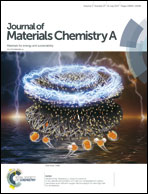Enhancing oxygen adsorption capabilities in Li–O2 battery cathodes through solid perfluorocarbons†
Abstract
Miscible and immiscible liquid perfluorocarbonates (PFCs), known for their exceptional oxygen transport properties, have been successfully incorporated into Li–O2 batteries, leading to improved battery performance. The desire to incorporate low vapour pressure PFCs during cathode preparation procedure encouraged the transition from liquid to solid PFCs. Such materials were added at different weight percentages to carbon black-based air electrodes and the performance of PFC-Li–O2 battery cells was investigated at different current densities and optimized [carbon:PFC:binder] composition. Discharge product investigation revealed a denser and a finer product (lithium peroxide, Li2O2) morphology through the entire cathode volume upon PFC incorporation, corresponding to the improved battery performance observed. The mesopore structure accomplished with the addition of PFCs was found to be highly advantageous, leading to lower charge transfer resistance and higher electrolyte penetration rate and uptake when added on the expense of higher molecular weight fluorinated binder, i.e. polyvinylidene fluoride (PVDF). Electrochemical investigation at different experimental and electrode preparation conditions conducted with and without PFCs-modified cathodes, indicated that enhanced oxygen adsorption capabilities are the main reason for the uniform deposition of discharge products at the electrolyte-facing side, which is commonly bare of products, and ultimately for the improved battery performance observed upon PFCs addition.



 Please wait while we load your content...
Please wait while we load your content...